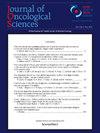The Incidental Diagnosis of Lung Cancer Through Chest Tomography During the COVID-19 Pandemic
Q4 Medicine
引用次数: 0
Abstract
: This study aims to determine the frequency of incidental lung cancers detected during chest computed tomography (CT) scans performed for guiding the diagnosis or treatment of coronavirus disease-2019 (COVID-19). Material and Methods: In this single-center retrospective study, the chest CT scans taken during the beginning of COVID-19 pneumonia (mostly pre-vaccination era) between April 2020 and December 2020 were examined. Patients who were younger than 18 years and those with a prior history of cancer were excluded. Moreover, the clinicopathological factors and radiologic findings of those patients with pulmonary nodule size on CT ≥ 3 mm or masses were recorded. Results: We assessed the CT scans of 2994 patients. A pulmonary nodule ≥ 3 mm or a mass was detected in 473 patients, while nine of them were diagnosed with lung cancer. The median age of lung cancer patients was 65 years (48-71 years). The most common subtype of lung cancer was adenocarcinoma (44.4%), followed by squamous cell carcinoma (33.3%) and small cell lung cancer (22.2%). Furthermore, all patients were diagnosed at the non-metastatic stage. Conclusion: Our study showed that early-stage lung cancers were detected incidentally on CT scans in suspected COVID-19 pneumonia patients. While the COVID-19 pandemic resulted in significant mortality worldwide, early diagnosis and treatment of these cases can save several lives.新冠肺炎大流行期间胸部断层扫描对肺癌的偶发诊断
本文章由计算机程序翻译,如有差异,请以英文原文为准。
求助全文
约1分钟内获得全文
求助全文
来源期刊

Journal of Oncological Sciences
Medicine-Oncology
CiteScore
0.10
自引率
0.00%
发文量
16
审稿时长
29 weeks
 求助内容:
求助内容: 应助结果提醒方式:
应助结果提醒方式:


